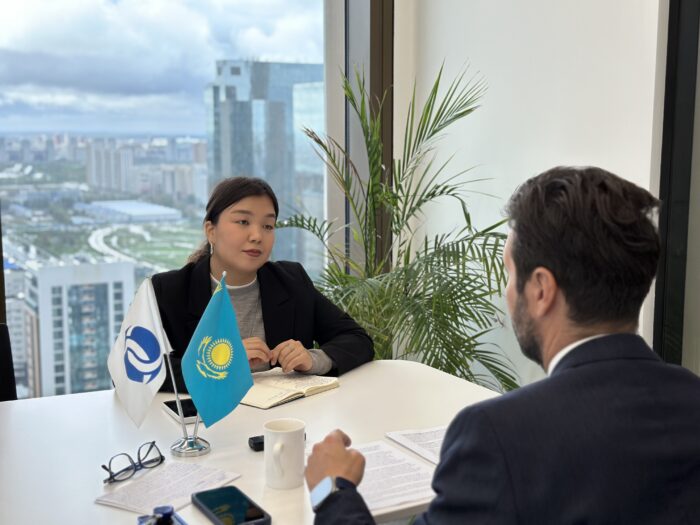ASTANA – The European Bank for Reconstruction and Development (EBRD) is set for a record-breaking year of investments in Central Asia, with a focus on sustainable energy and infrastructure projects. In a recent interview with The Astana Times, EBRD Acting Managing Director for Central Asia Hüseyin Özhan outlined the bank’s ambitious plans, which aim to support the region’s economic development.

In June, Hüseyin Özhan has been appointed acting Managing Director for Central Asia. He also continues working in his current capacity of EBRD Director for Kazakhstan. Photo credit: Nargiz Raimbekova/ The Astana Times
Key deals across Central Asia
For EBRD, 2024 has not been easy, but Özhan is optimistic, as the bank has “more impact and more projects.” The EBRD has signed 86 projects in Central Asia this year, representing investments close to 1.4 billion euros (US$1.56 billion).
“These numbers indicate that we might actually have a record year in terms of total investments in Central Asia,” said Özhan.
The numbers already surpass the bank’s results for the entire year of 2023—more than 1.2 billion euros (US$1.3 billion) in more than 100 projects in the region, driven by a good level of cooperation with the national authorities across Central Asia and improvements in the investment climate.
More than 70% of those projects are in the private sector, and almost 60% of investments were green.

The Astana Times journalist Assel Satubaldina and Hüseyin Özhan. Photo credit: Nargiz Raimbekova/ The Astana Times
Özhan spoke about key projects that EBRD signed in 2024 in Central Asia, which, along with Kazakhstan, the Kyrgyz Republic, Tajikistan, Turkmenistan, and Uzbekistan, also includes Mongolia.
In Uzbekistan, a significant achievement was the financing of the Tashkent Solar project, which includes the largest battery storage system in both Central Asia and the Commonwealth of Independent States. It represents a facility of up to $229.4 million for the development, design, construction and operation of a 500-megawatt-hour (MWh) battery energy storage system and a 200-megawatt (MW) solar photovoltaic power plant in the Tashkent region.
The bank also recently signed its second hydrogen project in Uzbekistan, marking a pivotal moment for renewable energy in the region. The project includes a 20 MW electrolyzer and a greenfield 52 MW wind power plant, with the EBRD providing a $65 million financial package to ACWA Power UKS Green H2 for the facility’s development, design, construction, and operation.
“It is an extremely important project for Central Asia, and especially for Uzbekistan,” said Özhan, highlighting the project aligns with the Paris Agreement’s goals.
Tajikistan has also seen a growing engagement with the EBRD. One of the key projects was the inauguration of the first three upgraded power-generating units at the Qairokkum Hydropower Plant (HPP) on Sept. 7, marking a significant step in Tajikistan’s energy modernization efforts.
The 60-year-old facility, which supplies electricity to more than half a million people, is undergoing a climate-resilient overhaul as part of a $196 million financing package led by the EBRD. The project involves major structural upgrades, including dam reinforcement and the installation of state-of-the-art hydraulic steel components, turbines, and electromechanical equipment.
Pipeline of projects in Kazakhstan
To date, the EBRD has allocated 10.3 billion euros (US$11.5 billion) across 327 projects in Kazakhstan, with the majority of investments directed toward promoting private entrepreneurship. Kazakhstan is the EBRD’s largest and longest-running banking operation in Central Asia. In 2024 alone, the bank has funded 15 projects worth more than 463 million euros (US$518 million).

In 2022, EBRD approved the new strategy for Kazakhstan for the next five years with a focus on private sector competitiveness, economic inclusivity, and carbon neutrality. Photo credit: Nargiz Raimbekova/ The Astana Times
“In Kazakhstan, we have had several proud moments this year,” said Özhan. One of them is the bank’s $41.99 million investments in the shares of Air Astana, the country’s largest air carrier, through an initial public offering (IPO).
The EBRD also provided financing for the largest municipal project in Central Asia to date by issuing a sovereign loan of up to 47.4 billion tenge (US$99.4 million) to the state-owned Aqtobe Su Energy Group. The funding will support the construction of a new wastewater treatment plant in Aktobe, replacing the outdated facility built in 1984. Once completed, the new plant can treat up to 100,000 cubic meters of contaminated water daily.
Özhan also highlighted a loan of up to 5.5 billion tenge (US$11.5 million) provided to Araltuz, Kazakhstan’s leading salt producer and one of the largest in Central Asia, in Kyzylorda. The funds will be used to build new manufacturing facilities for the domestic production of vacuum salt, also known as culinary salt.
“Another proud moment is the start of the operations of [a new international terminal] of the Almaty airport. It is long-awaited,” said Özhan. The EBRD contributed a long-term loan of $150 million as part of a broader $780 million financing package, which includes debt, equity, and operating cash flow. This marks the first major foreign direct investment in Kazakhstan’s airport infrastructure, setting a significant milestone for the country’s aviation sector.
Most promising sectors for investment in Central Asia
Addressing the sectors with promising potential, Özhan highlighted the vital role of renewable energy in Central Asia, calling it a “key sector” for the region’s future.
“Renewables, particularly, is a key sector for Central Asia overall, especially from our strategic engagement point of view. We are seeing quite a number of different international investors coming in. To name a few, we have Total Energies, Masdar, ACWA, and Voltalia,” said Özhan.
He also pointed out the leadership of Kazakhstan and Uzbekistan in this renewable energy push while noting significant hydroelectric power plants in the Kyrgyz Republic and Tajikistan, such as the Kambar Ata and Roghun projects, respectively.
For renewables to scale up, Özhan stressed the critical importance of digitalization and modernizing electricity transmission networks, with state-owned enterprises such as NEGU in Uzbekistan and KEGOC in Kazakhstan playing pivotal roles in expanding the region’s renewable energy capacity.
Özhan highlights significant investment opportunities in infrastructure projects, especially in transport and social infrastructure, with a focus on public-private partnerships (PPPs). In one such project, EBRD will provide 105 million euros (US$117.5 million) to construct and maintain a 630-bed hospital in Kokshetau in northern Kazakhstan. The project aims to replace outdated infrastructure, enhance healthcare services, and create new job opportunities. It will be the first internationally funded healthcare PPP in Kazakhstan.
Critical raw materials
Özhan also sees strong potential in critical raw materials. The region’s rich reserves of critical raw materials, particularly metals and minerals, are key to meeting the rising global demand for sustainable technologies.
Among these is graphite, a versatile material essential for the green energy transition. In August, the EBRD invested five million Australian dollars (US$3.4 billion) in Sarytogan Graphite Limited, an Australian Securities Exchange-listed company, which is exploring the Sarytogan graphite deposit in Kazakhstan’s Karagandy Region.
“Graphite is used in making jet engines. It is both very light, very hard, and resilient to heat,” said Özhan, noting that graphene, derived from graphite, can be ten times harder than steel.
“It is a junior mining project, but it shows our approach and confidence in the sector,” said Özhan.
With its vast resource base, Kazakhstan is strategically positioned to capitalize on the increasing global demand for these critical raw materials. “There is a saying that you can find every material that is on the periodic table in Kazakhstan in quantities that make it profitable to mine,” he said.
As the world shifts towards greener technologies, Kazakhstan’s competitive advantage becomes even more pronounced, particularly since many alternative sources of these materials are in sanctioned territories. “Kazakhstan can definitely, and should, bank on this competitive advantage,” added Özhan.
The EBRD has taken concrete steps to support the development of Kazakhstan’s mining sector. In May 2024, the bank signed a memorandum of understanding with the Kazakh government to modernize the sector. The agreement, formalized during the EBRD’s annual meeting in Yerevan, focuses on improving governance, transparency, and regulation per international standards.
“The main area that we will be focusing on is creating a modern and sophisticated system and approach to capturing, processing, and disseminating the geoscientific documents data. Most of the data that Kazakhstan has dates back to the Soviet times,” said Özhan. “If you can update and digitalize this geoscientific data, Kazakhstan can systematically approach to attract international investors.”
“It will be extremely beneficial and will help Kazakhstan to achieve the ambitious targets that are set by President Tokayev, which was also mentioned in September in his state-of-the-nation address,” he said.
Supporting private businesses
EBRD has been involved in several key PPP projects in Central Asia. One of the grand projects is the Almaty Ring Road, also known as BAKAD (Big Almaty Ring Road). This 66-kilometer half-ring road around the city, which became operational in 2023, is designed to remove a major transport bottleneck and increase the transit throughput capacity, boosting international trade while reducing local air pollution.
“I am very happy to see that President Tokayev’s address also refers to PPPs. PPPs are a method to finance projects and mobilize international private capital,” said Özhan, emphasizing that while Kazakhstan has a strong economy, its infrastructure investment needs are vast. To meet these needs, various financing mechanisms must be utilized.
“There is a big infrastructure program in the making by the government. We welcome this very much, and we will support it as well. Financing this ambitious infrastructure program requires utilizing all different types of financing available in the market,” he explained.
He added that the EBRD is also closely collaborating with the Ministry of National Economy on refining PPP laws and regulations, which were updated last year.


